The Norwegian Elkhound is a hardy gray hunting dog. These are the first words of the Official Standard. Any prospective breeder or judge can obtain a copy of this standard, read and study it. He or she can then proceed to follow either of these two ultra-important paths, feeling possessed with the knowledge needed and fortified with enough knowledge to produce excellent results.
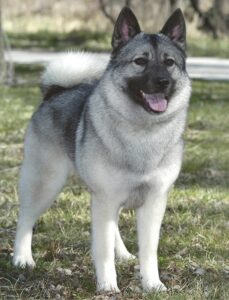 The sport of dogs requires successful breeders or judges possessing an intrinsic (go-with-your-gut) confidence based on knowledge and experience that can only be attained through constant learning/studying. I have always felt that if you produced a wonderful litter when first starting out, luck had befallen that breeder. As to judges, initial assignments are usually followed by a few reflections on, “Woulda, Could, Shoulda.” The quality breeders and judges get their feet under them and, ultimately, produce a quality result, time after time, with the aforementioned learning/studying.
The sport of dogs requires successful breeders or judges possessing an intrinsic (go-with-your-gut) confidence based on knowledge and experience that can only be attained through constant learning/studying. I have always felt that if you produced a wonderful litter when first starting out, luck had befallen that breeder. As to judges, initial assignments are usually followed by a few reflections on, “Woulda, Could, Shoulda.” The quality breeders and judges get their feet under them and, ultimately, produce a quality result, time after time, with the aforementioned learning/studying.
My goal here is to benefit current and prospective breeders and judges by giving you some of the background that is not mentioned in the wording of the standard. I would like to expand on the intimate characteristics of the Elkhound that years of experience has provided me. Often, little-known factoids stick in a person’s mind and lend themselves to greater interest in that breed.
Breed Judging | General Appearance:
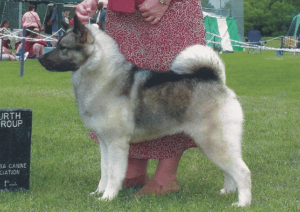 The gray dog is very difficult to see in the woods. The underbody and underside of tail are light silver, and help to provide the hunter (or the distressed owner of an escapee) with a sighting of their dog. The silver underside is vital to coat color—and in the woods. Imagine the courage of a 50-pound dog trailing and holding an antlered and sharp-hooved giant of an angry animal many times taller and weighing 1,200-1,500 lbs. After trailing for miles, he must hold the moose until his human can get there to bring down their quest. To this end, the dog can be a barker (much to the chagrin of neighbors). The hunter must find the moose, and his dog, since his two legs leave him in the moose’s and the dog(s)’ dust quite early in the hunt. The hunter must listen for his dog(s) in order to have a chance of finding them. The moose is a great swimmer and has good speed. Now, how impressed are you with the abilities of this dog? Did you know that many of today’s Norwegians still fill their freezers every fall with game he has killed with his Elkhounds?
The gray dog is very difficult to see in the woods. The underbody and underside of tail are light silver, and help to provide the hunter (or the distressed owner of an escapee) with a sighting of their dog. The silver underside is vital to coat color—and in the woods. Imagine the courage of a 50-pound dog trailing and holding an antlered and sharp-hooved giant of an angry animal many times taller and weighing 1,200-1,500 lbs. After trailing for miles, he must hold the moose until his human can get there to bring down their quest. To this end, the dog can be a barker (much to the chagrin of neighbors). The hunter must find the moose, and his dog, since his two legs leave him in the moose’s and the dog(s)’ dust quite early in the hunt. The hunter must listen for his dog(s) in order to have a chance of finding them. The moose is a great swimmer and has good speed. Now, how impressed are you with the abilities of this dog? Did you know that many of today’s Norwegians still fill their freezers every fall with game he has killed with his Elkhounds?
Breed Judging | Neck, topline and body:
The Norwegian Elkhound is not a dog built for speed, but rather for endurance. For agility, the body is short. The ribcage comprises most of its length, thereby providing the room needed for heart and lungs. They must have a hard, level topline, which denotes great musculature. Leg strength, the ability to leap and twist (to evade attack), stems from the topline as well. All of these attributes just “scream” athlete. The dog’s very survival has always been determined by his athleticism, intelligence, and the ability to think on the run.
Breed Judging | Coat: Thick and harsh to resist snow, ice, and freezing rivers and lakes. The outer coat keeps them warm and not wet enough to freeze, while the downy undercoat (that you find all over your floors and in your food) keeps them protected.
Breed Judging | Forequarter and Hindquarters: The Norwegian Elkhound paws are small and oval to travel easily over rough or icy terrain. Imagine a dog with large and/or open toes trying to cover rough terrain with such feet. Length of leg should be 50% (I, perhaps, like a little more – 52%) of the dog’s height. Please, please note that the ribcage does not hang down below the elbows. Both should meet in the same spot; heavy-bodied and/or short-legged dogs cannot make it as hunters. In Norway, there is a great deal of woods, underbrush, water, and fallen trees, all of which hamper the speed and progress of the shorter-legged, heavy-bodied, would-be hunters. The rear should have moderate angulation, providing the ability to leap and spin—avoiding antlers and hooves.
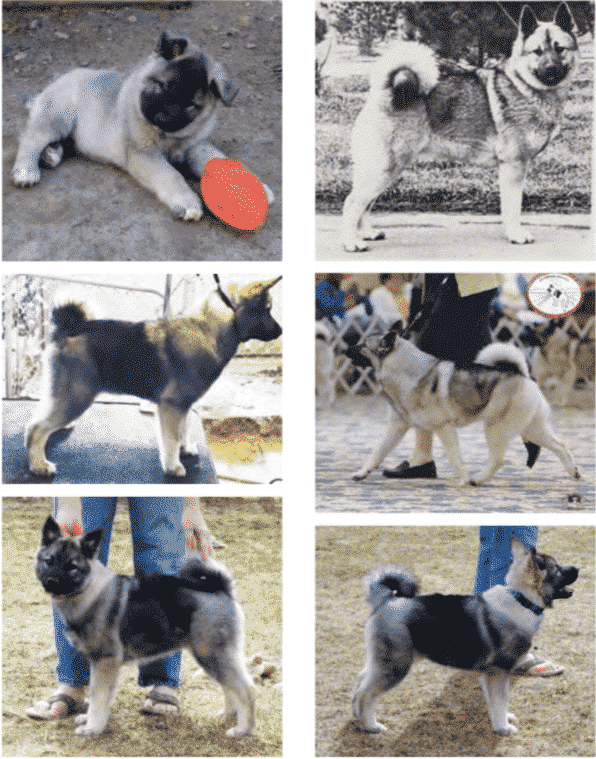
This is not a dog built for speed, but rather for endurance.
Breed Judging | Temperament: The Norwegian Elkhound is bold, energetic, and will sure let you know when UPS has arrived at your door. The Elkhound hunts far ahead of the hunter and must make his own decisions about how he will proceed. For this reason, as an independent thinker, he is not the “star” of the performance world. He is far from stupid and he learns quickly. But in training class and subsequent competitions, his general feeling is, “Been there, done that, my dear owner. So how dumb are you for needing to do this over and over?” Some comply out of love of the partnership and some just love the energy they get to expend, but all Elkhounds are smart, sensitive to their people, loyal, and happy.
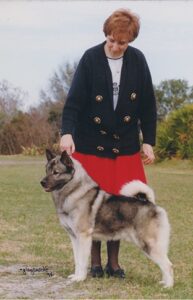 If asked to advise breeders and judges as to the paramount information on which to base their selections, I would list the following:
If asked to advise breeders and judges as to the paramount information on which to base their selections, I would list the following:
Above all, select the athlete who possesses a good headpiece for scenting ability, small ears that won’t freeze, arch of neck, and excellent layback with good return of upper arm, length of leg, hard level topline, long rib and short coupling, and high-set tail with ample rear angulation. His appearance must say, “I am the dog who can, despite harsh elements, long distance, and rough terrain, follow and contain the game.”
Judges, please keep in mind when judging the Hound Group that the Elkhound looks like no other dog in his Group. When considering your placements; evaluate your Elkhound on how well he fits his standard as a sound, energetic athlete. An extensive familiarity with this breed will, hopefully, have you considering them equally with the other more popular/safer breeds.


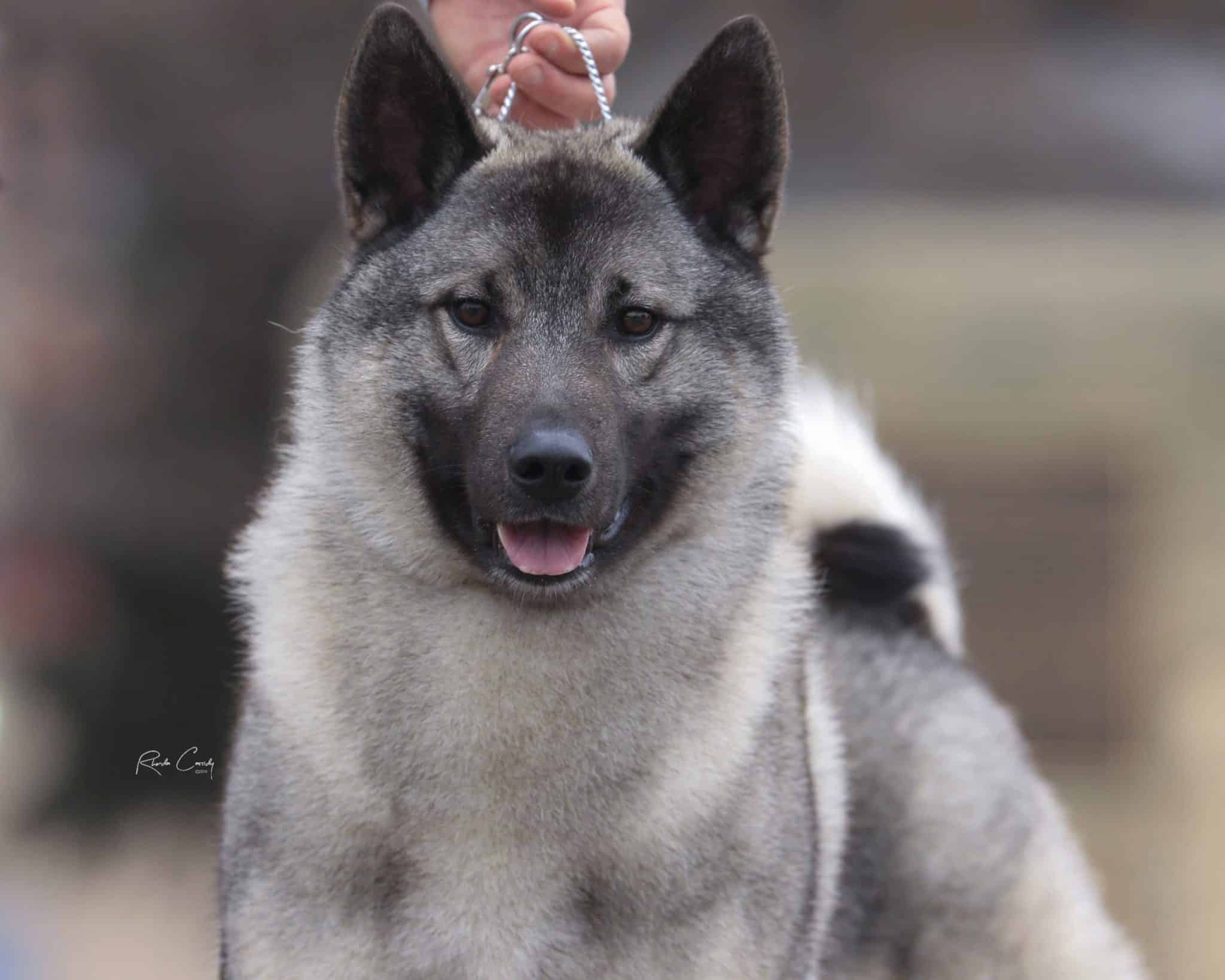
 The sport of dogs requires successful
The sport of dogs requires successful  The gray dog is very difficult to see in the woods. The underbody and underside of tail are light silver, and help to provide the hunter (or the distressed owner of an escapee) with a sighting of their dog. The silver underside is vital to coat color—and in the woods. Imagine the courage of a 50-pound dog trailing and holding an antlered and sharp-hooved giant of an angry animal many times taller and weighing 1,200-1,500 lbs. After trailing for miles, he must hold the moose until his human can get there to bring down their quest. To this end, the dog can be a barker (much to the chagrin of neighbors). The hunter must find the moose, and his dog, since his two legs leave him in the moose’s and the dog(s)’ dust quite early in the hunt. The hunter must listen for his dog(s) in order to have a chance of finding them. The moose is a great swimmer and has good speed. Now, how impressed are you with the abilities of this dog? Did you know that many of today’s Norwegians still fill their freezers every fall with game he has killed with his Elkhounds?
The gray dog is very difficult to see in the woods. The underbody and underside of tail are light silver, and help to provide the hunter (or the distressed owner of an escapee) with a sighting of their dog. The silver underside is vital to coat color—and in the woods. Imagine the courage of a 50-pound dog trailing and holding an antlered and sharp-hooved giant of an angry animal many times taller and weighing 1,200-1,500 lbs. After trailing for miles, he must hold the moose until his human can get there to bring down their quest. To this end, the dog can be a barker (much to the chagrin of neighbors). The hunter must find the moose, and his dog, since his two legs leave him in the moose’s and the dog(s)’ dust quite early in the hunt. The hunter must listen for his dog(s) in order to have a chance of finding them. The moose is a great swimmer and has good speed. Now, how impressed are you with the abilities of this dog? Did you know that many of today’s Norwegians still fill their freezers every fall with game he has killed with his Elkhounds?
 If asked to advise breeders and judges as to the paramount information on which to base their selections, I would list the following:
If asked to advise breeders and judges as to the paramount information on which to base their selections, I would list the following:




